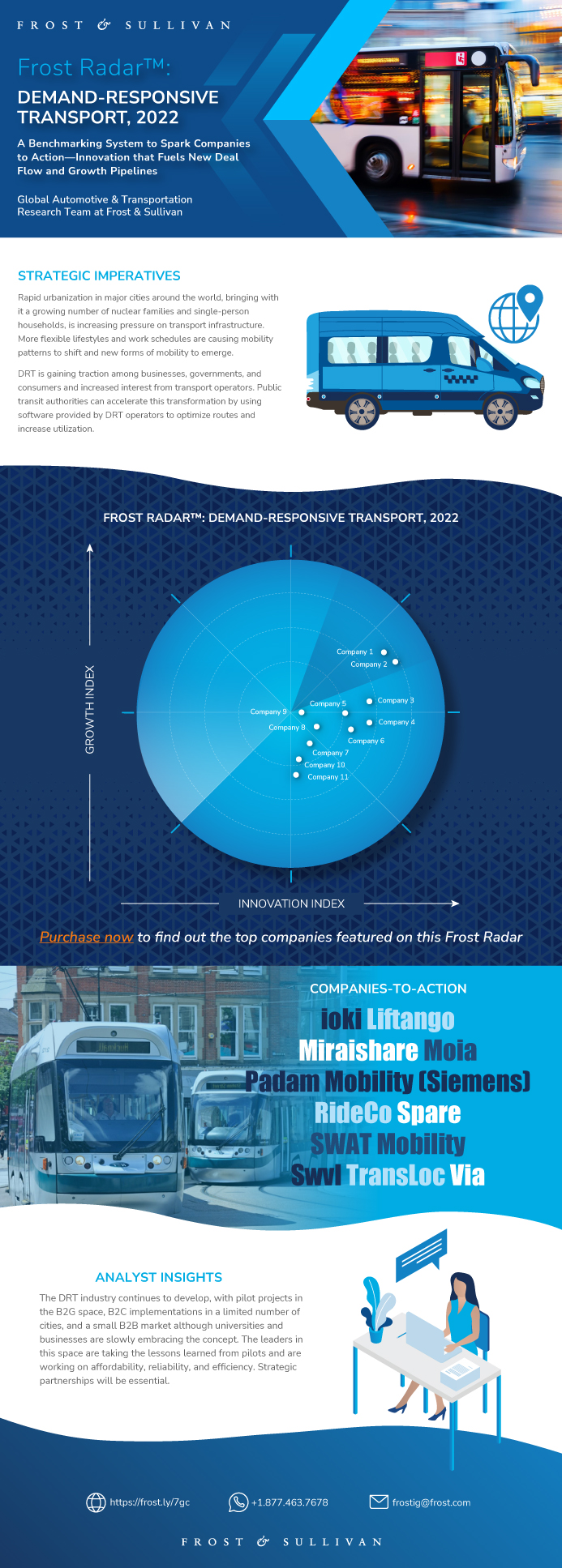Frost Radar™: Demand-responsive Transport, 2022
Frost Radar™: Demand-responsive Transport, 2022
A Benchmarking System to Spark Companies to Action - Innovation that Fuels New Deal Flow and Growth Pipelines
05-Jul-2022
Global
Frost Radar
Rapid urbanization in major cities around the world, bringing with it a growing number of nuclear families and single-person households, is increasing pressure on transport infrastructure. More flexible lifestyles and work schedules are causing mobility patterns to shift and new forms of mobility to emerge. Demand-responsive transport (DRT) would make a transport network more flexible and sustainable, solving numerous problems. DRT is gaining traction among businesses, governments, and consumers, and increased interest from transport operators.
Cities want their transportation networks to be more technology-enabled and efficient and seek to make the infrastructure building blocks more connected and intelligent. DRT can become a control center and a decision-making tool for municipal authorities as they analyze data, create simulation models, and implement solutions that bring about a rapid change in how people travel.
DRT is in the growth phase, and exponential growth will be propelled by evolving mobility needs, a focus on sustainability, and public-private partnerships. Some DRT operators are looking at combining people and goods delivery to be more profitable. Frost & Sullivan anticipates that DRT providers will generate more than $43 billion in revenue globally by 2030. Market consolidation is already happening. As the DRT market matures, new players will enter emerging markets and further consolidation is a possibility.
The Frost Radar™ reveals the market positioning of companies in an industry using their Growth and Innovation scores as highlighted in the Frost Radar™ methodology. The document presents competitive profiles on each of the companies in the Frost Radar™ based on their strengths, opportunities, and a small discussion on their positioning. Frost & Sullivan analyzes hundreds of companies in an industry and benchmarks them across 10 criteria on the Frost Radar™, where the leading companies in the industry are then positioned.
Author: Chanchal Jetha

Strategic Imperative
Growth Environment
Growth Environment (continued)
Frost Radar™: Demand-responsive Transport
Frost Radar™: Competitive Environment
Frost Radar™: Competitive Environment (continued)
ioki
Liftango
Miraishare
Moia
Padam Mobility (Siemens)
Rideco
Spare
SWAT Mobility
Swvl
Transloc
Via
Strategic Insights
Significance of Being on the Frost Radar™
Frost Radar™ Empowers the CEO’s Growth Team
Frost Radar™ Empowers Investors
Frost Radar™ Empowers Customers
Frost Radar™ Empowers the Board of Directors
Frost Radar™: Benchmarking Future Growth Potential
Frost Radar™: Benchmarking Future Growth Potential
Legal Disclaimer
Purchase includes:
- Report download
- Growth Dialog™ with our experts
Growth Dialog™
A tailored session with you where we identify the:- Strategic Imperatives
- Growth Opportunities
- Best Practices
- Companies to Action
Impacting your company's future growth potential.
| Deliverable Type | Frost Radar |
|---|---|
| Author | Chanchal Jetha |
| Industries | Automotive |
| No Index | No |
| Is Prebook | No |
| Podcast | No |
| WIP Number | PD6B-01-00-00-00 |